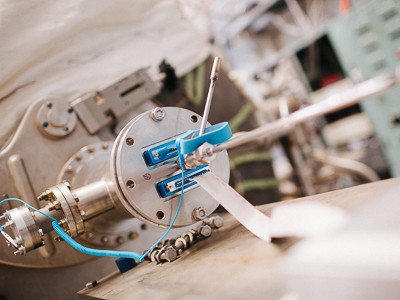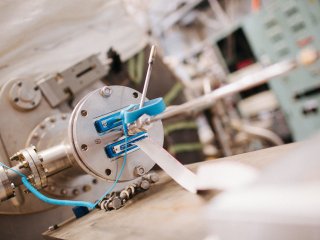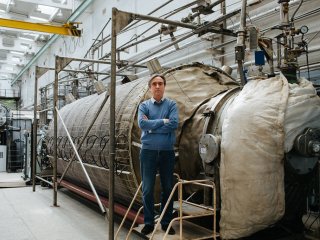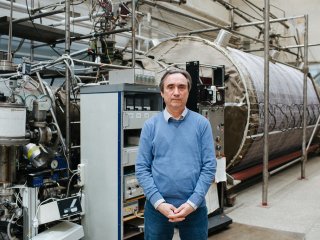If there is dark matter, what particles does it consist of? The answer has been pursued for several decades in Troitsk at the Institute for Nuclear Research, conducting a unique Troitsk nu-mass experiment.
I. V. Tkachyov, Head of the Department of Experimental Physics, Institute for Nuclear Research of the Russian Academy of Sciences, Member of the Russian Academy of Sciences, talks about it.
– Igor Ivanovich, we are in the sanctum sanctorum of your institute, in a chamber where a unique Troitsk nu-mass experiment is conducted. We see a famous installation, which institute employees lovingly refer to as the Barrel. As I understand, no experiment is carried out, as we speak. What is going on then? When is it conducted?
– The experiment is conducted in sessions, as the installation works for two to three consecutive weeks and then “rests” for several months. I wish, of course, it were carried out day and night, but that’s just impossible. When the work is in full swing right here, everything is buzzing really bad, because there are very many pumps in here. The “Barrel” is only one small part, an electrostatic spectrometer. To my right, for example, is a windowless gas source of tritium. It has lots of pumps circulating tritium. There are helium temperatures, superconductivity, because it’s all in the extremely strong magnetic fields. Superconductivity requires cryogenics. The liquid helium goes down the pipes to cool down magnets.
– How safe is it? Have you ever had any accidents?
– We are certified and have a license. Tritium is radioactive, but everything is effectively protected and under control. There were no accidents, although the installation is 30 years old.
– Igor Ivanovich, can you tell us what the Troitsk nu-mass experiment is all about?
– There are particles, called neutrinos, which many have heard about. They are very light, but they play a very important role. There are many of them. For example, several trillion neutrinos flying from the sun pierce a human every second. We don’t feel it, because they interact very weakly. And that’s why it is difficult to study them. Besides, they are different from all other particles of the Standard Model.
– As far as I understand, they do not fit in the Standard Model, which makes it impossible to consider this model complete.
– Yes, they don’t fit in the Standard Model. In 1956, even prior to the Standard Model emergence, the scientists discovered parity breakdown. They came up with a simple, elegant explanation that neutrinos are different, not like the other particles — they are massless. And if they are massless, they have very special properties. All other fermions, such as quarks, leptons, electrons, protons, have left- and right-handed components. It’s like taking a top and spinning it — you can spin it left- or rightwards. This is a crude analogy, but it gives a rough idea of the things. So do all the other particles: some are left-handed, others – right-handed.
– What does the parity breakdown mean?
– There are symmetry laws in physics. These symmetries ensure the existence of conservation laws. For example, homogeneity of space and time leads to conservation of momentum and energy. Another possible symmetry is a space reflection, which leads to parity conservation. That is to say, if we use analogies, a certain process and its reflection in the mirror are equal and do exist. All other particles except neutrinos act like that.
– And what about neutrinos?
– When the Standard Model was built, the scientists realized that neutrinos act differently. They do not reflect in this conditional “mirror.” Their reflections in the mirror do not exist in nature.
– Like vampires?
– Or like ghosts. If neutrinos are left-handed, they should spin rightwards in the mirror. But neutrinos are always left-handed and never right-handed. And to do that, they should be massless. But what if neutrinos have mass?
The most obvious way to explain the existence of mass in neutrinos is to suggest that there are right-handed neutrinos. But physics is an experimental science, nothing can be taken for granted, there are no dogmas, any postulates must be tested. Therefore, the question whether neutrinos are massive or massless was also tested by an experiment despite the structure of the Standard Model. Vladimir Mikhaylovich Lobashyov who built our installation was a pioneer in this field. Its construction began when I was a postgraduate student, in the early 80s. At that time, it was already being built. I have to say that there are many different installations to research neutrinos. They help learn fundamental laws of the universe where we live. But what makes our installation so unique is that it enables us to directly measure the neutrino mass.
– How?
– How do we search for the neutrino mass? There are electrons among tritium degradation products. We measure the spectrum of these electrons in a very precise manner. And if neutrinos have mass, the spectrum will look in a particular manner. Its spectrum will abruptly end some distance from the maximum, energy limit. And this distance will be equal to the neutrino mass. The scientists have been searching for the neutrino mass for many decades. Gradually, like always in science, improving limits, Lobashyov who worked here, in Troitsk, obtained the then world’s best neutrino mass limits. Our best limit is 2 electron volts.
– Is it some mass?
– No, it’s not mass. We now know exactly that neutrinos have mass, but it is one thing to know and it is another thing to measure it. And as the instrument sensitivity and accuracy improves, mass limits become higher. We got a record reading. In Troitsk, we learnt that the neutrino mass is less than 2 electron volts. But we couldn’t move any further, because any tool has a limit and it is no longer possible to improve the mass limit with our installation. And the international collaboration in Germany, in which we are directly involved, then built an installation, a larger copy of ours. It’s called KATRIN.
– Did they elaborate your data?
– Yes. It took several decades to build it. The project development began in 2000, but it was launched only two years ago. This is an expensive installation worth €200 million. A huge amount of money, big research teams and we are part of all this. KATRIN improved our limit. Today, the neutrino mass limit is 1 electron volt. We are very close to measure it. Because there is an upper mass limit and a lower mass limit. Mass cannot be too small. Although there is no guarantee that KATRIN will eventually measure the neutrino mass. We might probably need a different, much more powerful installation.
– So, maybe we should just build a more powerful installation right away?
– No, we can’t. Our installation can simply be made geometrically larger. And if KATRIN cannot find the neutrino mass, we will have to build a completely different installation. Our “Barrel” employs high space vacuum. KATRIN, which is ten times larger than ours in volume, has the largest volume of vacuum on Earth. You’d think the Large Hadron Collider is a ring 27 kilometers and it has more vacuum. No, KATRIN has more vacuum, because the Large Hadron Collider has a smaller diameter of the pipe, in which accelerated particles are flying. It will be impossible to build another “Barrel” with a larger volume of vacuum so that it would not collapse under pressure.
– Let us imagine that we finally know the neutrino mass. What do we do with this information?
– When the Large Hadron Collider was built, the scientists already knew that the Higgs boson existed. But they needed to find it and measure its mass. They did it and it was a true breakthrough. We now know the mass of the God particle, as it is poetically referred to and this is very important.
But it is a much more interesting task to know the neutrino mass. As I said, our installation exhausted itself in its measurements of the neutrino mass. But it’s working. So, what do we use it for? We use it to search for the right-handed neutrinos.
We know that all other particles are massive, because there are left- and right-handed neutrinos and it’s them that interact with the Higgs boson. Through this interaction of left- and right-handed particles with the Higgs boson, the particle acquires mass.
You can’t do this to neutrinos, if there are no right-handed particles. And if there are right-handed components, it’s quite possible. And if we find right-handed neutrinos, we will know the mechanism, thanks to which the neutrino acquires mass.
Why is it interesting? Naturally, it is not directly related to the national economy, although there can be most diverse applications. Like in the case of electromagnetic interactions, we first thought that there would be no applications, but now we cannot live without them.
So, what’s in here? We know that the Standard Model is incomplete. But there are two clearly known observable facts that are outside the Standard Model. One is that neutrinos have mass, because there are no right-handed neutrinos in the Standard Model, and so is mass.
– And the second fact is dark matter, isn’t it?
– Yes. We know for a fact that there is dark matter, but we cannot make dark matter from particles we know. As a result, there are many hypothetical nominates to become the particles constituting dark matter. But the most interesting particles are the ones that are introduced with a different, separate purpose. And that’s exactly the case of neutrinos. In order to explain the neutrino mass, we need right-handed components, also known as sterile neutrinos. And it’s them that can be dark matter.
– Do you search for dark matter?
– Yes, we search for warm dark matter. We have been improving our limits for 30 years and KATRIN picked up our torch. So, we have been searching for sterile neutrinos for a few years. KATRIN improved the neutrino mass limits, while we still have the best limits on sterile neutrinos, which could be dark matter.
– And what are they?
– Sterile neutrinos could be dark matter, if their mass is around one to dozens of kiloelectron volts, meaning that they are much heavier than the left-handed particles by about 10,000 times. In the contemporary understanding, neutrino can reflect in the mirror. But it doesn’t look like itself at all. There is a monster in the reflection.
– But why could that be the case? Doesn’t that contradict all the laws of physics?
– In the case of neutrinos, it’s quite possible.
– You mean, it’s like a fun house mirror when we look at ourselves and see fat giants.
– Yes, that’s about right. In the meantime, you cannot think that if we find sterile neutrinos, we find dark matter. We can find sterile neutrinos and they are light, less than 1 kiloelectron volt. In which case, they cannot constitute dark matter. Scientists can use different installations to study neutrinos. But studies in such an interesting area of masses can be carried out using only installations like ours or KATRIN. There are no other installations in the world just yet.
– Why do you call such neutrinos sterile?
– They are sterile, because they have no interactions in the Standard Model, but they have some other interactions. As a result, they acquire mass. When they have mass, the left-handed neutrinos can transform into the right-handed ones, or oscillate. This mixing parameter, a force, with which left- and right-handed neutrinos are bonded, defines how many neutrinos were born in the early universe. We have the best limits on this parameter of mixing left- and right-handed neutrinos in the world.
– Igor Ivanovich, I know that among a vast amount of your discoveries in astrophysics is an exotic hypothesis that there is a particle the size of a star, the so-called boson star. Can our Sun be a boson star?
– No, it can’t. Boson stars are a different area of our research. If there are boson stars, then dark matter is most likely not neutrinos. In this hypothesis, we need bosonic dark matter rather than neutrino, i.e., fermionic dark matter. Fermions are built so that two fermions are not in the same state. It’s impossible due to the Pauli exclusion principle. Bosons, on the contrary, like getting together. It’s called Bose condensation.
– Fermions are loners, while bosons are collectivists.
– Yes, all the particles in the nanoworld are either a boson, or a fermion. And if there is dark matter consisting of light bosons, then it can give rise to the Bose condensate of dark matter. It will then snowball into “stars” by action of its own gravity. And all of its particles are in the single quantum state! The Bose star has more than one particle, lots of them. How many depends on their mass. But this looks like it’s a single particle, because all of them are in the same state.
– And where can we find such stars?
– I’m talking about them in theory. But there is one more nominee for dark matter, also very natural, axion, which theorists proposed to solve a different problem. And this is boson. I talked about parity breakdown. Then, Landau introduced combined parity, which many thought should last. But then it turned out that combined parity also breaks down in weak interactions. It doesn’t break down in strong interactions alone. And we don’t know why. In order to explain this paradox, scientists came up with such a particle, as axion, which solves the problem of why combined parity doesn’t break down in strong interactions.
And it turned out that these axions can also become excellent nominees to assume the role of dark matter. They are also very light, lighter than neutrinos. Since they are light, Bose condensation is very efficient and they get Bose condensed in a natural way thanks to gravity. Today, scientists plan and conduct very many experiments, during which they try to find axions in the laboratory. Axion is a very interesting particle and if it exists, there are many places it can appear. Some researchers seek to find axions in the solar radiation. We also take part in this experiment. If we find solar axions, we will also understand a lot. For instance, we can understand if they can or cannot constitute dark matter.
Axions also interact very weakly. They are very hard to find. But if they form boson stars, they can also be observed astrophysically. For example, through gravitational lensing, when we can find them within a certain mass spectrum of these stars and understand that these are some objects, which cannot be made from our common baryons. It means that this is something different and this could be an axion star. And there is a much more interesting probability. Axions interact electromagnetically. An axion falls into two photons. Within a star, this process can operate like a laser, amplifying itself. If there is a powerful blast, all radiation will be in a line equal to half the mass of axion. Something similar can happen, if an axion star flies by a neutron star, where there are very strong magnetic fields. And then a boson star can transform into radiation very fast. This will be a colossal energy release in radio waves. In fact, scientists see similar bursts, which they call fast radio bursts. They are being studied. Not necessarily, of course, that these fast radio bursts are explosions of axion stars...
– But it is not unlikely.
– It is not unlikely indeed. But even if they cannot explain fast radio bursts, this line from axion breakdown can be studied by means of radio telescopes. They can be used to search for such line in the galaxy, for example. Such experiments are also slated. They will be conducted and we will take part in them.
–Igor Ivanovich, honestly, don’t you feel frustrated that you spent 30 years using the installation to search for the neutrino mass and didn’t find any and now you are trying to find dark matter and don’t know if you will. That’s how the whole scientific life fled and you didn’t find anything...
– No, not frustrated at all, because every step in this search is important and necessary. This is interesting to us. Besides, this is not the only thing we do. That’s how the science works. The scientists have been searching for the Higgs boson for half a century. The search for gravitational waves, which were just discovered, began in the 1960s. The time of loners is gone. It is a group endeavor, often an endeavor of entire generations of scholars.





























